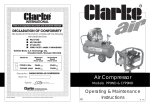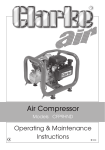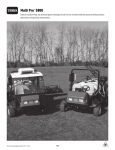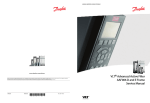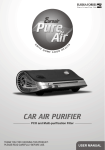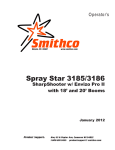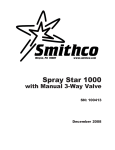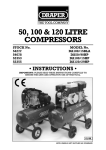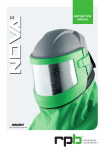Download Clarke PPH15ND Specifications
Transcript
Air Compressor PP10ND • PPH10ND • PP15ND • PPH15ND Operating & Maintenance Instructions © 1002 SPECIFICATIONS PP10ND Part Number Engine Type WARNING! DO NOT ATTEMPT TO ALTER ENGINE SPEED SETTINGS DOING SO WILL INVALIDATE YOUR GUARANTEE Spare Parts and Service Contacts For Spare Parts and Service, please contact your nearest dealer, or CLARKE International, on one of the following numbers. PARTS & SERVICE TEL: 020 8988 7400 PARTS & SERVICE FAX: 020 8558 3622 or e-mail as follows: PARTS: [email protected] SERVICE: [email protected] 2090940 PPH10ND PP15ND 2090960 HONDA GX120 HONDA GX120 209080 HONDA GX200 PPH15ND 2090100 HONDA GX200 Pump Type MK101 MK101 MK103 MK103 Air Receiver size 50 litres 50 litres 50 litres 50 litres Max. output Pressure 100psi 100psi 100psi 100psi Air Displacement 9cfm 9cfm 15cfm 15cfm Outlet connectors 1/4” BSP 1/4” BSP 1/4” BSP 1/4” BSP Dimensions (mm) Weight (kg) Sound Power Level 940x410x780 1010x450x780 940x410x810 1010x450x810 71 62 99dBLWA 99dBLWA 70 98dBLWA 74 98dBLWA NOTE: Specifications are correct at the time of going to press. Clarke International reserves the right to change specifications at any time, as it sees fit, in the interests of safety or improvement in design. PARTS & SERVICE CONTACTS If you have any problems using or setting up your Compressor call the Clarke Helpline on, 020 8988 7400 Press 1 for Parts : 2 for Technical Assistance Copyright: Clarke International, All rights reserved. June, 2002 -2- For Spare Parts and Service, please contact your nearest dealer, or CLARKE International, on one of the following numbers. PARTS & SERVICE TEL: 020 8988 7400 PARTS & SERVICE FAX: 020 8558 3622 or e-mail as follows: PARTS: [email protected] SERVICE: [email protected] - 17 - Read these safety instructions before using the equipment. INTRODUCTION Thank you for purchasing this Clarke portable compressor. The unit is powered by a Honda engine, a manual for which, is provided separately. Please refer to that manual for all matters relating to the engine, ...starting and stopping procedures, maintenance etc. GUARANTEE This product is guaranteed against faults in manufacture for 12 months from purchase date. Please keep your receipt as proof of purchase. This guarantee is invalid if the product has been abused or tampered with in any way, or not used for the purpose for which it is intended. The reason for return must be clearly stated. This guarantee does not affect your statutory rights. CONTENTS Page Guarantee ...................................................................................................................... 3 For your Own Safety ...................................................................................................... 4 Important General Notes .............................................................................................. 5 General Layout .............................................................................................................. 6 Preparation for Use ........................................................................................................ 7 Starting the Compressor ................................................................................................ 8 Shutting Down the Compressor .................................................................................... 9 Maintenance ................................................................................................................. 10 Parts Lists and Diagrams ............................................................................................. 11-13 Troubleshooting ............................................................................................................. 14 Parts and Service Contacts ......................................................................................... 11 Troubleshooting ............................................................................................................. 14 Specifications ................................................................................................................ 17 Parts and service Contacts .......................................................................................... 17 - 18 - -3- FOR YOUR SAFETY WARNING As with all machinery, there are certain hazards involved with their operation and use. Exercising respect and caution will considerably lessen the risk of personal injury. However, if normal safety precautions are overlooked, or ignored, personal injury to the operator, or damage to property may result. It is in your own interest to read and pay attention to the following rules: General Precautions ALWAYS • ensure that all individuals using the compressor have read and fully understand the Operating Instructions supplied. • stop the engine and ensure the pressure is expelled from the air receiver BEFORE carrying out any maintenance. • ensure that there is adequate ventilation when spraying flammable materials e.g. cellulose paint, and keep clear of any possible source of ignition. • protect yourself. Think carefully about any potential hazards which may be created by using the air compressor and use the appropriate protection. e.g. Goggles will protect your eyes from flying particles. Face masks will protect you against paint spray and/or fumes. • consult paint manufacturers instructions for safety and usage, before spraying • ensure that the air supply is turned off at the machine outlet and all pressurised air from the machine and other equipment attached to it, is expelled BEFORE disconnecting air hoses or other equipment. • make sure that children and animals are kept well away from the compressor and any equipment attached to it. • ensure that any equipment or tool used in conjunction with your compressor, has a safety working pressure exceeding that of the machine. NEVER • direct a jet of air at people or animals, and NEVER discharge compressed air against the skin. COMPRESSED AIR CAN BE DANGEROUS! • leave pressure in the receiver overnight, or when transporting. • adjust, or tamper with the safety valves. The maximum pressure is factory set, and clearly marked on the machine. • operate in wet or damp conditions. Keep the machine dry at all times. Similarly, a clean atmosphere will ensure efficient operation. Do not use in dusty or otherwise dirty locations. • touch the machine until it has cooled down...some of the metal parts can become quite hot during operation. • operate your compressor with any guards removed. -4- - 17 - Compressor unit runs Large amount of condensation in on and off load more air receiver. frequently than usual. Leaks in control unit or inspection cover. Too little pressure differential. Leaks in pipework system. Compressor unit runs ‘on load’ when no air is being used. Compressor’s oil consumption rising. Adjust pressure switch. Locate and repair leaks. Too much oil in compressor. Check oil level 2 or 2 minutes after stopping. Leaks around crank case. Change seal and inspect packing surfaces. Repair or replace defective parts. Working temperature of Increase ventilation to air compressor too high because of compressor. insufficient cooling. Oil in the air delivered. Fire Prevention Drain off condensation AT LEAST once a week. Locate leaks (by means of soapy water) and repair. Semi-automatic unit: Load too small. Convert to fully automatic operation. Cylinder worn. Replace worn parts or send compressor pump for an overhaul. Intake air filter blocked. Change air filter. Sump over full. Reduce oil to correct level. ALWAYS • switch the engine OFF when refuelling. • refuel away from any source of heat. • refuel in a well ventilated area. NEVER • overfill the tank, fill to the level specified. • smoke whilst refuelling and avoid smoking or using a naked flame near the compressor. • start the engine if there is spilled fuel. Any spillage must be wiped clean and the compressor allowed to dry before attempting to start the engine. Exhaust Gas Precautions ALWAYS • ensure there is adequate ventilation when using the compressor. • position the compressor so that the exhaust is pointed away from people or animals . Cylinder worn. Replace worn parts or send compressor pump for an overhaul. Governor controlled unit running Convert to automatic control. off load for too long a period. Intake air filter blocked. Change air filter. Oil level rises although no oil has been put in. Condensation in oil pump. Compressor over dimensioned. Condensation at outlet points. Piping installation incorrect. Consult your local dealer. Compressor taking in air which is too warm. Obtain better fresh-air supply to compressor. Delivery temperature of air from air receiver too high. a) Use a larger air receiver. b) Insert an aftercooler. - 16 - ! NEVER WARNING: Exhaust fumes can be fatal • use the compressor indoors or in an enclosed area. (i.e. in a warehouse, tunnel, well, hold etc.) IMPORTANT General Notes • NEVER allow anyone, not fully familiar with compressors, to use this equipment. • DO NOT alter the engine settings....these settings are set at the factory. Should they need recalibration - consult your Clarke dealer -5- Suction rendered difficult or Larger fresh-air inlet. impossible at suction intake, or the air being taken in is too warm. Fig.1 Unusual noise from compressor. Compressor becomes too hot. Pressure gauge defective. Change pressure gauge. Unit too small in relation to air consumption. Connect a supplementary compressor or install a larger model. Compressor worn. Have compressor overhauled or replace it. Bolts loose. Tighten bolts. Flywheel loose. Tighten flywheel. Unit installed on an unsuitable base. Move unit to a more solid base. Bearings, piston rings or cylinder worn. Replace worn parts or change compressor pump. Valve broken. Change valve parts. Bearings of electric motor worn. Have motor bearing replaced. Insufficient ventilation. See that sufficient air is supplied to flywheel or fan of compressor and that hot air is properly vented. Oil level too low (check 2 or 3 times after stopping). Fill with oil – see Page 10. Wrong direction of rotation. Cooling air from flywheel fan must blow against compressor. Fault in valves (machine not stopping). Check, clean/replace. Blown head gasket (machine not stopping). Check and replace gasket. Dirt on cooling fins or suction filter. Clean cooling fins and suction filter. Unit working at too high a pressure. Reset to correct working pressure detailed on unit. Not fully unloading (Governor control machines only). Check pressure unloading genie, adjust if necessary, check valve(s). Non-return valve partly blocked. Clean or that out non return valve. Compressor being overworked and running continuously. -6- - 15 - Connect to a supplementary compressor or install a larger model. TROUBLE SHOOTING CHART PREPARATION FOR USE IMPORTANT 1. Any remedial work that may be required must be carried out by a qualified engineer. A. Environmental • Ensure the compressor is sited on a firm level surface. 3. Drain the Air Receiver before dismantling any part of the compressor unit’s pressure system. • Ensure the environment is dry and dust free. 4. If your compressor develops a fault do not use until the fault has been rectified. • 2. Switch off the engine before removing any parts from the compressor. 5. For troubleshooting the engine, refer to the engine manual. SYMPTOM Engine difficult to start PROBABLE CAUSES REMEDY Load Genie leaking (compressor unit is on load during start). Stop engine and empty air receiver. Clean or replace Load Genie Non-return valve blocked, possibly frozen up. Thaw Load Genie out (Unit must be installed in frost-free place). Pressure switch defective. Have pressure switch changed by an electrician. Pressure switch set at a pressure higher than the safety valve’s opening pressure. Adjust pressure switch or safety valve. Bleed valve under pressure switch blows whilst compressor is not running. Load Genie leaking. Bleed valve under pressure switch blows whilst machine is running. Load Genie leaking. WARNING: DO NOT ADJUST SAFETY VALVE ABOVE MAXIMUM WORKING PRESSURE DETAILED. CleanLoad Genie or replace. Air intake to compressor b) Cooling for compressor pump c) Engine exhaust gases. B. Engine Check oil and fuel levels and a visual check of components. Refer to engine service manual. C. Pump • Compressor unit constantly ‘on load’ Ensure there is adequate ventilation for: a) Check oil level on the Dipstick - to level marked. D. Fuelling ! Fill with unleaded petrol, according to the instructions within the engine manual. • Ensure the fuel tap is set to the required position. • Ensure The fuel hose and connectors are intact, in perfectly serviceable condition and there is no leakage. Note : Always use a funnel to fill the fuel tank so as to avoid accidental spillage of fuel. If fuel is spilled it must be removed from the unit and surrounding area, before attempting to start the engine. E. Receiver Clean Load Genie or change pressure switch. • Drain off any condensate, by opening the drain cock (see Fig. 1). Remember to close the cock when completed. NOTE: This should be carried out DAILY when the compressor is in constant use. Compressor constantly Suction filter blocked. ‘on load’ and cannot Leak between compressor attain the working block and air receiver leaks in pressure required. or near air receiver. Change filter. F. Air Hose & Air Tool Tighten connection and repair leak. • NOTE: Quick fit nuts are provided. These may be removed if a 1/4”BSP is required. Valves blocked by dirt, paint, dust or choked up. Clean or change valves. Inspection cover or plug leaking. Empty air receiver and change seal. - 14 - Attach the air hose to the outlet using an appropriate connector. • Attach the air tool/spray gun to the air hose...If using snap couplings, use a whip end, available from your Clarke dealer. -7- STARTING THE COMPRESSOR PUMP PARTS Initial Start-up 1. Fully open the receiver drain cock, (located between the wheels). 2. Start the engine, according to the instructions contained in the engine service manual, and allow to run for 10 minutes. 3. After a ten minute period, close the drain cock then ensure both air outlet sliding valves are pushed fully INWARDS to close the outlet. Pressure will build up in the receiver and eventually the air governor will operate so that the engine runs off load. The pressure registered on the pressure gauge should be 100psi. 4. Slide the outlet taps outwards to allow air to escape from the outlets, and slowly turn the pressure regiulator clockwise. Observe the pressure gauge. When the pressure has dropped by approx. 20psi, the regulator will cut in again. Close the sliding outlet valves and pressure in the air receiver will once again increase 5. Finally, stop the engine and set the pressure regulator to zero pressure (turned fully anticlockwise) and attach the air hose and air tool. 6. Open the sliding valves then set the pressure regulator to full pressure and check for air leaks at the tool and connectors. • • If leaks are apparent, stop the engine and set the regulator to zero pressure (fully anticlockwise), press the trigger of the tool to ensure no air is present in the airline, then rectify the problem before proceeding. If no leaks are evident, set the outlet pressure to the desired value and proceed to use the air tool in accordance with the manufacturers instructions. Fig.2 -8- 10ND 15ND No. Description Part No. Part No. 1 Screw 2 3 Lower Cover Casing 014013054 113149015 014013054 113149015 4 5 Bearing Seal 113167001 033027000 113167001 033027000 6 7 Front Cover Screw 010053000 113149008 010053000 113149008 8 9 Flywheel Washer 014013021 013160010 014013021 013160010 10 11 Screw Screw 014005001 113160011 014005001 113160011 12 13 Washer Rear Cover 014013082 014005025 014013082 014005025 14 15 Oil Dipstick Screw 113149009 012036000 113149009 012036000 014010044 16 17 Crankshaft Connecting Rod 18 19 Piston Ring Kit Circlip 20 21 Gudgeon Pin Piston 22 23 Complete Piston Cylinder 24 25 Valve Holder Plate Head 26 27 Filter Cartridge Intake Filter 28 29 Screw Conveyor 30 31 Screw Complete Seal Kit 32 33 Manifold Automatic Discharge Valve 014010044 113167003 113149004 213115002 015098000 113115025 113115026 413115026 113169002 413149080 113149050 017024000 317026000 014002041 113150002 014006121 - 13 - 213168001 - 113167003 113150004 213167001 015023000 116025006 113164009 413167006 113167002 413167005 113150022 017003000 317001000 014002041 113150002 014006121 213167002 116091024 011158000 When starting subsequently, start the machine as follows: PUMP PARTS 1. At the beginning of the day, open the drain cock and allow any condensate to drain completely, then close the cock. 2. To ease starting, ensure there is no pressure in the pump outlet manifold by opening the Bleed Valve (See Fig.2). 3. Connect the air hose to one of the outlets and the air tool and set the pressure regulator to zero pressure (turned fully anticlockwise). 4. Start the engine in accordance with the instructions contained in the engine service manual, then close the bleed valve and allow pressure to build up. 5. When the the regulator/cut-out has operated, slide the outlet valve outwards fully then adjust the pressure regulator so that the desired pressure is registered on the gauge. 6. Check for air leaks at the tool and connectors...as above, before proceeding STOPPING THE COMPRESSOR At the end of the day, stop the compressor in accordance with the instructions in the engine manual, then open the drain cock. Close the air outlet by sliding both valves inwards. Operate the air tool trigger or operating lever etc., to ensure there is no pressure in the air line, then disconnect airline and tool. WARNING! DO NOT under any circumstances attempt to remove the air tool or disconnect the air hose until you are satisfied that the pressure has been relieved. Finally, close the drain cock. Take care not to touch the engine or pump as they remain hot for some time after use. - 12 - -9- MAINTENANCE PARTS LIST PP10ND PPH10ND DAILY a. Drain Air Receiver of any condensate b. Check engine oil level and top up where necessary. Ensure the dipstick breather hole is not blocked. c. Check pump oil level HS17210-ZE0-822 HS17210-ZE1-822 HS17218-ZE0-821 HS17218-ZE1-821 HS98079-56846 HS98079-56846 1. HS28442-ZH8-003 1. HS28442-ZH8-003 2. HS28442-ZH8-003 2. HS28442-ZH8-003 3. HS28462-ZH8-003 3. HS28462-ZH8-003 `5100610 `5100610 2100177 2100177 50mm Pressure Gauge 2000175 2000175 Safety Valve Complete 2000180 2000180 Drain Cock 2000220 2000220 V-Belt 2100061 2100063 WEEKLY a. PP15ND PPH15ND Clean Pump Air Filter 1. PP10ND Unscrew pump air filter from inlet manifold. Remove cover and check air filter. Wash in warm soapy water if necessary, rinse thoroughly and replace when completely dry. If it is damaged in any way, replace. Clean the plastic housing thoroughly before reassembly. 2. PP15ND Turn Pump Air Filter cover and pull away to reveal paper element. If badly contaminated, replace. Remove any loose contaminants if any then replace. b. Clean the engine cooling fins. 6 MONTHLY Renew pump lubricating oil. Fig.3 Drain pump by removing the drain screw (Arrowed in Fig.3). Replace screw and top up until oil is level with the mark on the dipstick, using SAE40 oil available from your Clarke dealer as follows: Compressor oil - 1 litre: Part No. 3050810 Compressor oil - 1 litre: Part No. 3050802 In addition to the above, check the engine manual for service schedule. Repairs should only be carried out by a qualified engineer. If problems occur, contact your Clarke dealer. - 10 - Wheel 2100289 2100289 Wheel Retaining Clip 2100306 2100306 Soft Rubber Foot 2100313 2100313 Pump Complete. 1390080 (MK101) 1390085 (MK103) Pulley 2100085 2100084 Engine complete 800047 (GX120QH) 800055 (GX200QH) Manifold 3-way CBM45469000 CBM45469000 Air Receiver 1999705 1999705 - 11 -










